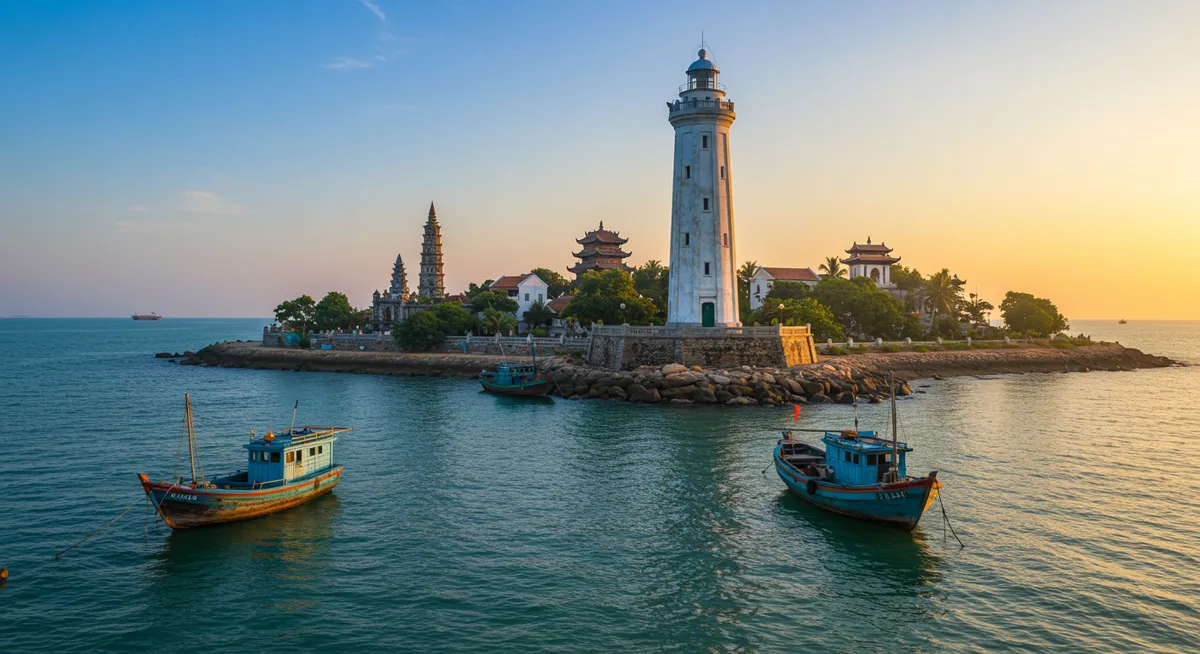
Explore Historical Sites in Vung Tau, Vietnam
Table of Contents
Want to find the best travel deals for this destination? Chat with our travel hacking specialist!
Get Travel HacksCategory: historical-sites-in-vung-tau
Unveiling Vung Tau's Rich Past
As a seasoned travel writer who's explored Vietnam extensively, I’ve found Vung Tau to be more than just a beach destination; it’s a treasure trove of history. Venturing through the city’s past offers a unique insight into its evolution. When you visit Vung Tau, immersing yourself in its rich heritage through its many historical sites in Vung Tau is an absolute must. These landmarks tell fascinating stories, from French colonial influence to spiritual devotion, providing a profound connection to the region's cultural fabric. Let's delve into these captivating destinations and uncover the soul of this coastal gem, perfect for any traveler seeking depth beyond the shores.
The Christ of Vung Tau: A Majestic Landmark
Standing majestically atop Mount Nho, the Christ of Vung Tau (or Christ the King statue) is undoubtedly one of the most iconic historical sites in Vung Tau. Completed in 1993, this towering 32-meter figure resembles Rio's Christ the Redeemer and offers breathtaking panoramic views of the city and coastline. Visitors can ascend 133 steps inside the statue to reach its arms, experiencing a unique perspective. I remember climbing those steps; the effort is genuinely rewarded by the stunning vista. This site symbolizes both religious significance and a testament to modern Vietnamese artistry, making it a compelling stop on any historical exploration of the area. It's a key part of the unique landscape you'll discover in Vung Tau.
Vung Tau Lighthouse: Guiding Ships and History
Perched on Small Mountain (Nho Mountain), the Vung Tau Lighthouse is not only an active navigational aid but also one of the oldest operational lighthouses in Vietnam, marking it as a significant historical site in Vung Tau. Built by the French in 1862, then rebuilt in 1910, its classic colonial architecture and elevated position provide incredible views. Accessing the lighthouse involves a pleasant, winding road or a brisk walk. From my own visits, the journey up is as rewarding as the destination, offering glimpses of the city below. The adjacent old cannon fort adds another layer of historical intrigue. Consider how to arrive from nearby cities; for instance, learn more about how to get from Ho Chi Minh City to Vung Tau easily.
Bach Dinh (White Palace): Colonial Elegance
Bach Dinh, also known as the White Palace, is a stunning example of French colonial architecture and a prominent historical site in Vung Tau. Built in 1898 as a retreat for the French Governor-General of Indochina, Paul Doumer, it later served as a summer palace for Vietnamese emperors. The palace’s pristine white exterior, surrounded by lush gardens and overlooking the sea, evokes a sense of bygone elegance. Inside, antique furniture and historical artifacts provide a glimpse into the lives of its former occupants. Walking through its grand halls, I always feel transported to a different era, imagining the dignitaries who once strolled these very rooms. Visiting Vung Tau's top spots requires good planning, and our Vung Tau travel guide can help you make the most of your trip.
Hon Ba Temple: Spiritual Sanctuary on the Sea
Off the coast of Vung Tau, Hon Ba Temple offers a unique blend of spiritual significance and natural wonder, solidifying its place among the captivating historical sites in Vung Tau. This small temple, dedicated to the Goddess of the Sea, sits on a tiny island accessible by foot only during low tide, via a rocky path. The experience of walking across the seabed to reach the temple is unforgettable and adds to its mystique. Dating back over a century, the temple embodies the local reverence for the ocean. As a traveler, I found the journey itself a highlight, a testament to the strong spiritual connection locals have with their environment. Understanding the best time to visit Vung Tau is crucial for planning your low-tide walk.
Frequently Asked Questions
Are there any entrance fees for Vung Tau's historical sites?
Can I visit these sites year-round?
Exploring the historical sites in Vung Tau offers a deeply rewarding journey beyond its renowned beaches. From the commanding Christ Statue to the serene Hon Ba Temple, each landmark narrates a unique chapter of this coastal city’s past, shaped by diverse cultural influences and spiritual traditions. Immersing yourself in these historic treasures provides a profound appreciation for Vung Tau’s vibrant heritage. Plan your visit to truly uncover the soul of this Vietnamese gem. Discover the best of Vietnam's coastal charm by embarking on this historical adventure.